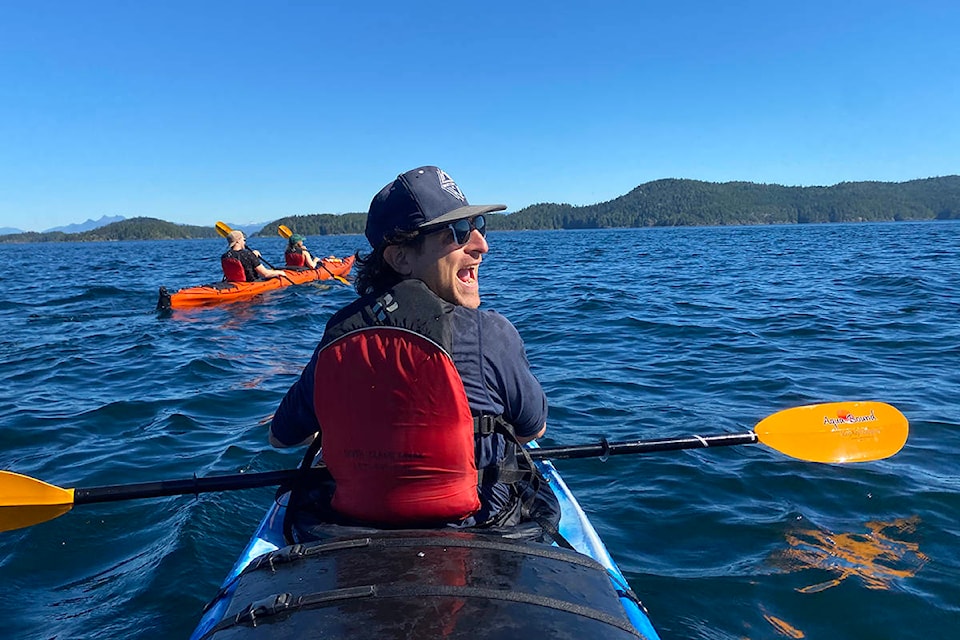You never know what you’re going to get on an ocean kayak trip.
Rain? Wind? Blistering sun that sears exposed shoulders and bounces off the water to burn the underside of your chin? It could all happen.
Ocean trips are unpredictable. There are forecasts, of course, and trends and patterns.
August tends to be foggy – hence the north Island nickname ‘Fogust.’ Humpbacks tend to follow certain routes, and orcas return to the same pebbly beaches to rub their bellies.
A foggy morning indicates a hot afternoon, the ‘Namgis say.
And yet, the best planned trip is still uncontrollable. There’s an allure to the not-knowing. The thrill is when we get it right.
It’s the same in fishing. How many hours is a fisherman willing to wait for one nibble that makes it all worthwhile?
Near the tail-end of a deeply challenged tourism season, North Island Kayak is still selling out tours – at half-capacity of six instead of 12 guests – to locals exploring their own backwaters.
It’s not a whale watching trip, per se.
The description says there’s a 50-50 chance of spotting orcas or humpbacks, but it’s on everyone’s mind paddling out from Telegraph Cove. Two minutes of paddling past the marina and the four kayaks take a right into Johnstone Strait. Hanson Island ahead and Blackfish Sound beyond, clear blue below.
Kingfisher Wilderness Adventures out of Port McNeill kept offering their multi-day trips, but only as private groups. Their sister company Alder Bay Kayaks took people out on day trips.
There are almost two dozen kayak touring companies on Vancouver Island, representing several dozen more seasonal jobs. This season has been lean. Tours normally start in May and operate through late September or even October. This year, guides were on hold until mid-June, when they had to turn their focus to local clients instead of the usual fare of international guests. Some companies stayed closed, hoping for a better 2021.
For those that did operate, results have been mixed, but North Island outfits told the Gazette they were able to keep about half of their guides employed. With help from wage subsidies and the enthusiasm British Columbians have shown for exploring the home they can’t leave, the season as been as good as could have been hoped for.
One guide said she preferred the local clients. European paddlers are likely to come with a list of wildlife they want to check off, whereas locals show up ready to enjoy the day, whatever it brings.
RELATED: Visiting the present past at U’mista Cultural Centre
RELATED: Raft Cove: reward for the muddy
A group-guided tour adds its own variable to ocean adventuring. As an individual traveller, you could get stuck in a tandem boat with someone who tells terrible dad jokes, or can’t work the rudder to save their life. But here’s where another trend can be helpful – people who like outdoor adventures tend to be awesome.
Whether there are whales or not in the Johnstone Strait, which starts around Telegraph Cove and meets up with the Discovery Passage 110 kilometres to the east, is a glorious place to paddle. The water is clear, the land is protected and lush, and the sea life is abundant.
Kelp forests create nice homes for schools of growing fish, buffets for kelp-eating urchins, and small islands for birds or even crabs to take a rest. They’re also rather fun to paddle through.
Across the strait are Hanson and Plumper Islands, as well as parts of ‘Namgis First Nation reserve land. Beyond Blackfish Sound is Malcolm Island, home of Sointula.
Stellar sea lions, far larger than the ubiquitous dock-napping California sea lions, have a small colony on the Plumper Islands where the Broughton Archipelago begins.
The stellars, a possible 50-million-years-ago distant relative to the bear, are fierce and violent.
They present as fat, lazy creatures with a glorious golden-brown coat, but these sea-grizzlies are nimble when they want to be. Beware, ye curious kayaker.
Even an adolescent sea lion could topple a small boat, never mind a fully grown 1,000-pound male adult. That is, if their barks, belch and stenches don’t keep you safely away.
Harbour seals with their endearingly puppy-like faces are curious, but shy. The bald eagle is stoic on its perch, storeys above the water level, seeing everything. Urchins, anemones and starfish light up the water below.
In the distant, the guide’s radio chatters something about humpback whales circling a whale-watching Zodiac, but by nearby the fish are jumping and sea lions are frolicking – yes, frolicking – in the water ahead, and oh, was that an otter?!
The whale is no longer the payoff.
Do you have something to add to this story or something else we should report on? Email: zoe.ducklow@blackpress.ca
